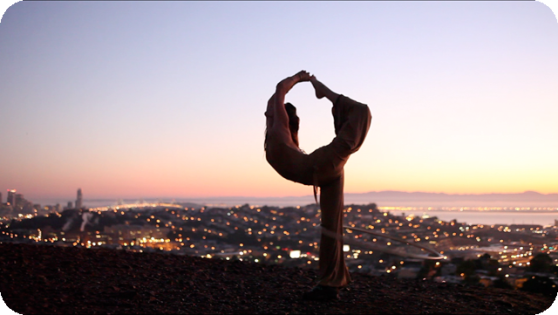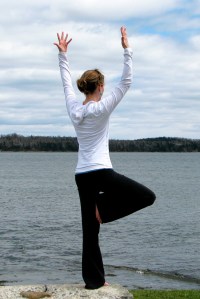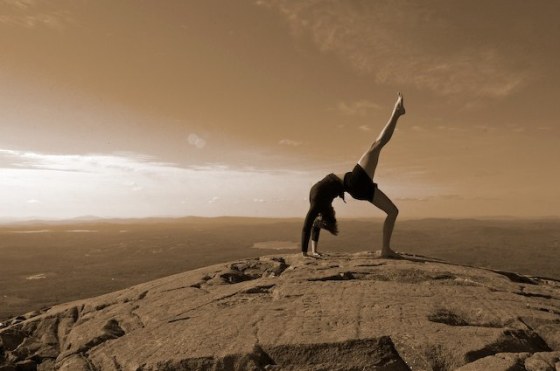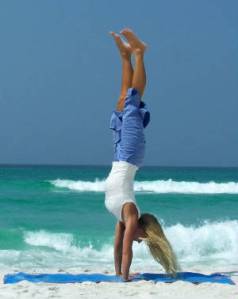 What is balance all about? And how do you DO it?
What is balance all about? And how do you DO it?
Well the truth is that you don’t ‘do’ it, you CREATE it.
Imagine a set of weighing scales. Those classic ones where 2 trays are suspended on opposite sides of a central stand. In order for it to work you need 2 sides of the equation to ‘balance’ each other out.
The concept is simple. Left has to balance with right. In yoga, the nature of our body brings added complication to this simple equation.
Your body is far more complex than the 2 dimensional balancing required in a set of scales. There are several of these simple physical systems to balance. You learn over time how to create equilibrium between many of these overlapping systems.
So when you are talking balancing yoga poses it is not just about the right equation it is about creating balance in quite a number of equations in your physical body.
Learn To Create The CONDITIONS For Balance
You have to be able to let go of the idea of balancing on one leg and shift your thinking to that of doing the right combination of actions to create the equilibrium right across multiple systems in your body.
Within the balance equation of your physical body are other equations that require balance too.
In my opinion the most important one is that of effort and surrender.
This is harder to measure but the results you get by practicing regularly create the learning. 
The Two Extremes Of Practicing A Yoga Pose
You may have caught yourself – or someone has told you that you are – simply hanging out in a pose. This is when you manage to approximate the pose but you are really just going through the motions.
Mind you it can take a lot of energy learning HOW to do these poses in the way that benefits you.
Unfortunately, understanding what “hanging out” means only comes retrospectively when you have REALLY worked out the pose!
On the other end of that scale you could be using so much effort that there are areas of your body that should not be being used.
They are supposed to be yielding and letting go. The effort -surrender continuum takes some time for your body to understand.
Too much effort (which is not effectively balanced by surrender) means you will fall out or have to contort your body to stay upright, or you will be fighting your own efforts to stay in the pose.
 Balance Is CONTINUOUSLY CREATED
Balance Is CONTINUOUSLY CREATED
Are you beginning to see that balance is not static but DYNAMIC? You don’t simply move into a position and “stay balanced”.
If you are constantly overbalancing one way, you have to work out what you have to do to find stability – by creating an
equal and opposite movement or action.
A wobbling ankle in a single leg balancing pose can move front to back and side to side. When you are new to yoga or one legged balance in general then the movements can be quite large. This is due to a number of things.
You could be quite weak and not have much strength to support you. The weight moves to the left and to stop you falling over your body reacts by throwing your weight to the right. The inside of your foot could lift too. If your body doesn’t overdo it (fall out or ‘over balance’) your foot will ground itself
again and continually re-correct itself back and forth.
Over time your ankle not only strengthens but your envelope of balance becomes refined. The movements become smaller until they are almost undetectable.
 Be Careful If Nothing Is Happening
Be Careful If Nothing Is Happening
If your ankle is not making any movements while you are balancing then you have to look at what’s going on.
In this case, when you allow the body to take over and use its own intelligence to keep you upright, movements could happen to create balance that are not in keeping with good yoga technique.
How You Make Balance Easier, But NOT Your Poses
Let me explain.
Next time you pick up say, your right leg for Standing Head to Knee, take some attention to your left foot.
Notice if it has changed position.
Your unconscious mind creates corrections to stop you falling over. If you are not paying attention your left foot could shift itself so that the toes are fanning out to the left.
In this way your body is making your balance far easier by removing the side-to-side part of the balance equation (and even lessening the front-back challenge).
In keeping with my theory about balancing many equations, your balance is easier because you only have some of the front to back balance to work on.
This is more simple in any case because you have that thing called a foot, spread out on the floor which is providing more stability.
The problem is that you are inadvertently creating other imbalances in your body (in your knee and hips for starters). These imbalances can eventually lead to dysfunction and even to some kind of condition with or without pain.
Another way to remove the side-to-side balance challenge is to lean into your arches or collapse your ankle inward. This is called pronation. If you are not lifting up through your ankle and balancing that with an active footprint then your pose will be compromised.
 In essence your balance requires both conscious and unconscious elements. That is an equation too! Start with the WRONG conscious stuff (set up incorrectly) then your body will take over, doing its best to manage and unconsciously cause
In essence your balance requires both conscious and unconscious elements. That is an equation too! Start with the WRONG conscious stuff (set up incorrectly) then your body will take over, doing its best to manage and unconsciously cause
dysfunction as a result.
Start with CONSCIOUS AWARENESS and correct set-up and your body will respond and benefit you.
How To Improve Your Balancing Skills
So here’s what to do:
* Place your conscious attention on creating a sound and solid pose foundation. This is your set-up.
* Aim to carry through correct conditions of alignment from the get-go til you let go.
* When you are in the pose there is the constant interplay of opposing forces and interconnecting systems.
* You can’t have your attention on every nuance but you can have your mind on technique, correct effort and mindful surrender.
* Let go of the things that we all sometimes get fixated on during practice. These are the distractions of your physical environment (eg heat) or even a technical part of the pose that you pay attention to, to the exclusion of everything else!
 Let’s Look At A Pose To See How This Works:
Let’s Look At A Pose To See How This Works:
It takes time to work out what your balance means with Standing Bow. Once you ‘get’ this pose and I mean really GET this pose then you will experience the hugest shift.
Firstly you will just be standing there kind of having a pretty strenuous time kicking the leg back and counting down til you get to the end (hanging out, or just figuring out).
Then one day your body discovers the balance it can create by a whole lot of little equations.
* You start to feel that glorious work of kicking back the leg balanced with the work your front arm does.
* Plus that sensation of surrendering the arm behind to the force of your kicking leg.
* Feeling the hips and lower spine open against the stability of both the standing and kicking leg.
* The arms working to open shoulders and the spine.
There will be days where you feel something flagging and you start to fall out.
But if you truly understand that it is not about TRYING to stay upright but it is about what tractions or work you create in your body then you will intuitively KNOW what it is that you let slide, turn it back on and stay upright!
Now here’s a challenge for you … what OTHER poses could you discover more about the “dynamic” balance involved?
Namaste.
